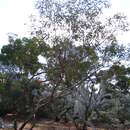en
names in breadcrumbs


Eucalyptus roycei ist eine Pflanzenart innerhalb der Familie der Myrtengewächse (Myrtaceae). Sie kommt an der Westküste von Western Australia vor[1] und wird dort „Shark Bay Mallee“ genannt.[2]
Eucalyptus roycei wächst in der Wuchsform der Mallee-Eukalypten, dies ist eine Wuchsform, die mehr strauchförmig als baumförmig ist, es sind meist mehrere Stämme vorhanden, die einen Lignotuber ausbilden; oder als Baum,[3] der Wuchshöhen von 2 bis 6 Meter erreicht.[4] Die graue, grau-braune oder gelbe Borke ist am gesamten Baum glatt und schält sich in kurzen Streifen oder kleinen, mehreckigen Flicken. Öldrüsen gibt es sowohl in der Borke als auch im Mark.[3]
Bei Eucalyptus roycei liegt Heterophyllie vor. An mittelalten Exemplaren sind die Laubblätter sitzend, elliptisch, gerade, ganzrandig und matt grau-grün. Die gegenständigen, auf Ober- und Unterseite gleichfarbig matt grünen Laubblätter an erwachsenen Exemplaren besitzen eine Blattspreite, die lanzettlich, breit-lanzettlich oder eiförmig, sich zur Spreitenbasis hin verjüngt, ein spitzes oder zugespitztes oberes Ende besitzt und gerade oder sichelförmig gebogen sein kann. Die erhabenen Seitennerven gehen in einem spitzen Winkel vom Mittelnerv ab. Die Keimblätter (Kotyledone) sind nierenförmig.[3]
Seitenständig an einem im Querschnitt stielrunden oder vierkantigen Blütenstandsschaft stehen in einem einfachen Blütenstand nur etwa drei Blüten. Die Blütenknospen sind eiförmig oder zylindrisch und nicht blaugrün bemehlt oder bereift. Die Kelchblätter sind auf vier Zähne auf dem Blütenbecher (Hypanthium) reduziert. Die glatte Calyptra ist halbkugelig oder konisch, so lang wie der gestreifte oder gerippte Blütenbecher und breiter als dieser. Die Blüten sind gelb oder cremeweiß.[3] Die Blütezeit reicht in Western Australia von Januar bis März.[4]
Die gestielte Frucht ist zylindrisch. Der Diskus ist eingedrückt, die Fruchtfächer sind eingeschlossen.[3]
Das natürliche Verbreitungsgebiet von Eucalyptus roycei liegt an der mittleren Westküste von Western Australia an der Shark Bay.[1] Eucalyptus roycei kommt nur im selbständigen Verwaltungsbezirk Shark Bay in der Region Gascoyne vor.[4]
Eucalyptus roycei gedeiht auf Sandebenen auf kalkhaltigen, roten Sandböden.[4]
Die Erstbeschreibung von Eucalyptus roycei erfolgte 1969 durch Stella Grace Maisie Carr und Dennis John Carr in Proceedings of the Royal Society of Victoria, Volume 83, S. 159.[2][5][6] Das Typusmaterial weist die Beschriftung „E. M. Scrymgeour and S. G .M. Carr 284. PERTH; paratypes, E. M. Scrymgeour and S. G. M. Carr 293, 297. PERTH“ auf.[2]
Eucalyptus roycei ist eine Pflanzenart innerhalb der Familie der Myrtengewächse (Myrtaceae). Sie kommt an der Westküste von Western Australia vor und wird dort „Shark Bay Mallee“ genannt.
Eucalyptus roycei, commonly known as Shark Bay mallee,[2] is a species of mallee or a small tree that is endemic to a small area along the Gascoyne coast of Western Australia. It has rough fibrous or flaky bark on the lower trunk, smooth greyish bark above, lance-shaped to curved adult leaves, flower buds in groups of seven or nine, cream-coloured or pale yellow flowers and cylindrical to barrel-shaped, four-sided fruit.
Eucalyptus roycei is a mallee or a small tree that typically that grows to a height of 2–6 m (6 ft 7 in – 19 ft 8 in) and forms a lignotuber. It has rough fibrous or flaky greyish bark at the base, smooth greyish to cream-coloured bark above. Young plants and coppice regrowth have egg-shaped to lance-shaped leaves that are 60–125 mm (2.4–4.9 in) long and 30–60 mm (1.2–2.4 in) wide. Adult leaves are the same shade of dull greyish green on both sides, lance-shaped to curved, 65–140 mm (2.6–5.5 in) long and 18–30 mm (0.71–1.18 in) wide, tapering to a petiole 10–30 mm (0.39–1.18 in) long. The flower buds are arranged in leaf axils in groups of seven or nine on an unbranched peduncle 9–28 mm (0.35–1.10 in) long, the individual buds on pedicels 2–6 mm (0.079–0.236 in) long. Mature buds are cylindrical to oval, 14–21 mm (0.55–0.83 in) long and 8–11 mm (0.31–0.43 in) wide with a conical to rounded operculum and a four-sided floral cup. Flowering occurs between January and March and the flowers are white, cream-coloured or pale yellow. The fruit is a woody, cylindrical to barrel-shaped, four-sided capsule 15–30 mm (0.59–1.18 in) long wide with the valves below the level of the rim.[2][3][4]
Eucalyptus roycei was first formally described in 1970 by Maisie Carr, Denis Carr and Alex George in Proceedings of the Royal Society of Victoria. The type specimen was collected near Hamelin Pool in 1966 by Eleanor Marion Scrymgeour and Maisie Carr.[5][6][7] The specific epithet (roycei) honours Robert Dunlop Royce who was a member of the staff of the Western Australian Herbarium.[6]
Shark Bay mallee is found on sand plains in the Gascoyne region centred around Shark Bay where it grows in red calcareous sandy soils.[2] The mallee is part of the tree heath community found in Shark Bay at the overlap of the South West botanical province and the Eremaean botanical province. Associated species include Eucalyptus beardiana, Grevillea rogersoniana, Acacia drepanophylla, Banksia ashbyi and Grevillea rogersoniana.[8]
The plant is fast-growing and is wind-, drought- and frost-tolerant. It is usually grown in a full-sun position in well-drained soils. Although it is not regarded as a very attractive tree, it is available commercially for bush or park settings.[9]
Eucalyptus roycei, commonly known as Shark Bay mallee, is a species of mallee or a small tree that is endemic to a small area along the Gascoyne coast of Western Australia. It has rough fibrous or flaky bark on the lower trunk, smooth greyish bark above, lance-shaped to curved adult leaves, flower buds in groups of seven or nine, cream-coloured or pale yellow flowers and cylindrical to barrel-shaped, four-sided fruit.
Eucalyptus roycei là một loài thực vật có hoa trong Họ Đào kim nương. Loài này được S.G.M.Carr, D.J.Carr & A.S.George mô tả khoa học đầu tiên năm 1970.[1]
Eucalyptus roycei là một loài thực vật có hoa trong Họ Đào kim nương. Loài này được S.G.M.Carr, D.J.Carr & A.S.George mô tả khoa học đầu tiên năm 1970.